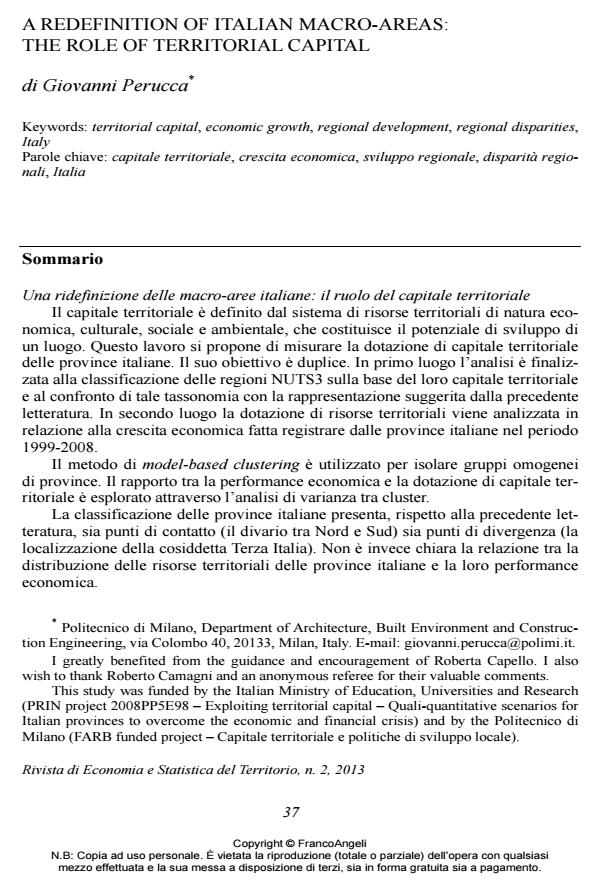A redefinition of italian macro-areas: the role of territorial capital
Journal title RIVISTA DI ECONOMIA E STATISTICA DEL TERRITORIO
Author/s Giovanni Perucca
Publishing Year 2013 Issue 2013/2
Language Italian Pages 29 P. 37-65 File size 926 KB
DOI 10.3280/REST2013-002003
DOI is like a bar code for intellectual property: to have more infomation
click here
Below, you can see the article first page
If you want to buy this article in PDF format, you can do it, following the instructions to buy download credits

FrancoAngeli is member of Publishers International Linking Association, Inc (PILA), a not-for-profit association which run the CrossRef service enabling links to and from online scholarly content.
Territorial capital is defined by the system of territorial assets, of economic, cultural, social and environmental nature, that ensures the development potential of places. This paper is devoted to an empirical estimation of territorial capital endowments in Italian provinces. Its objective is twofold. The first goal is to classify Italian NUTS3 regions based on their endowments of territorial capital and to compare the resulting taxonomy with the geographical representation provided by the previous literature. The second objective is to investigate the relationship between local endowments of territorial assets and the economic performance of Italian provinces in the period 1999-2008. Methods and Results Model-based clustering is applied to the territorial capital components with the objective to isolate homogeneous groups of regions. The link between the economic performance of the clusters and their territorial assets is assessed through a oneway analysis of variance. Conclusions Compared with previous literature, the partition of Italian provinces presents both similarities (the gap between North and South) and unconformities (the localization of the so-called Third Italy). The relationship between the distribution of territorial assets across regions and their economic performance is not clear.
Keywords: Territorial capital, economic growth, regional development, regional disparities, Italy
Jel codes: O18, O40, R11, R12
- EU regional development policy and territorial capital: A systemic approach Ugo Fratesi, Giovanni Perucca, in Papers in Regional Science /2019 pp.265
DOI: 10.1111/pirs.12360 - Regeneration of the Built Environment from a Circular Economy Perspective Ugo Fratesi, Giovanni Perucca, pp.29 (ISBN:978-3-030-33255-6)
- The Resilience of Cultural Landscapes Fabrizio Aimar, pp.97 (ISBN:978-3-031-55860-3)
- The influence of the local context on the implementation and impact of EU Cohesion Policy Julia Bachtrögler, Ugo Fratesi, Giovanni Perucca, in Regional Studies /2020 pp.21
DOI: 10.1080/00343404.2018.1551615 - New Metropolitan Perspectives Vincenzo Provenzano, Maria Rosaria Seminara, pp.46 (ISBN:978-3-031-34210-3)
Giovanni Perucca, A redefinition of italian macro-areas: the role of territorial capital in "RIVISTA DI ECONOMIA E STATISTICA DEL TERRITORIO" 2/2013, pp 37-65, DOI: 10.3280/REST2013-002003